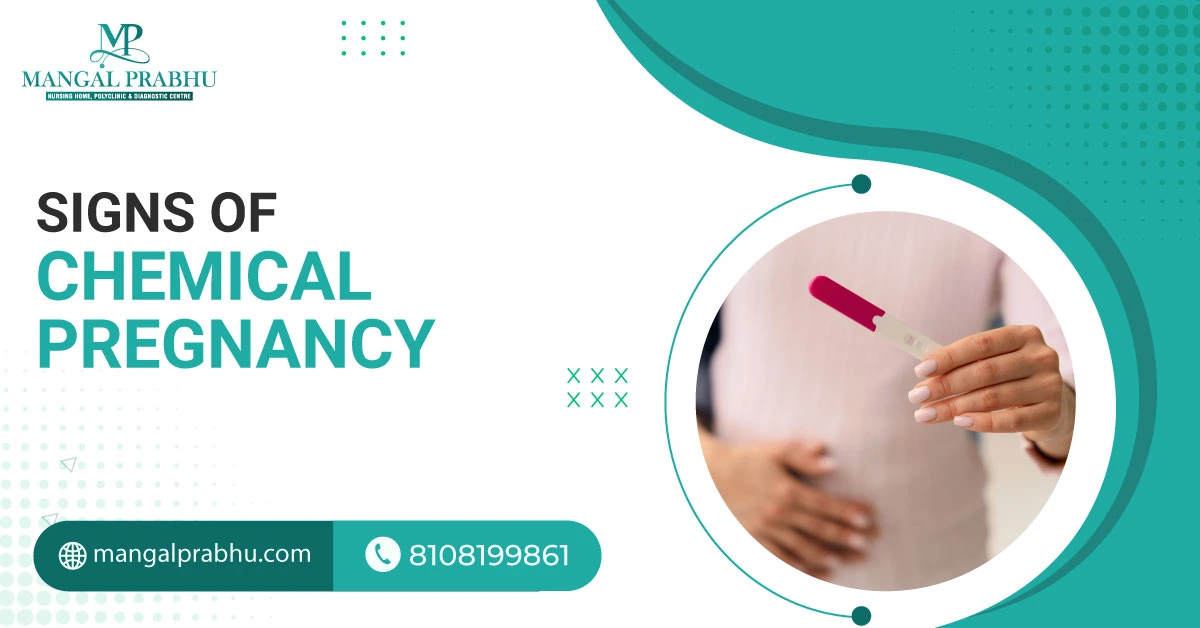
Signs of Chemical Pregnancy
Not every pregnancy is carried to term. A chemical pregnancy refers to an early miscarriage or termination of a pregnancy before five weeks. It’s so early that some women don’t even realize they are pregnant and had a miscarriage, especially if the pregnancy ends soon after the missed period. Chances are your pregnancy won’t be visible on the ultrasound.
It’s important to know the signs of chemical pregnancy and head to the nearest maternity hospital in Navi Mumbai if you experience the symptoms mentioned below:
Early Signs of Chemical Pregnancy
Chemical pregnancy can make you an emotional wreck. Having a miscarriage right after the positive pregnancy test is not just physically exhausting but is equally tough on your mental health. Here’s what to watch out for:
1) Bleeding:
It may start with spotting, which gradually develops into heavy period-like bleeding. Your period might arrive late.
2) Lower Abdominal Cramps:
When your pregnancy doesn’t progress, your body will start to shed the uterine lining, which results in mild cramping. It mimics your period cramps, so it’s often hard to tell whether it’s just the regular monthly cramps or pregnancy-loss cramps.
3) Drop in hCG Levels
Your hCG levels rise drastically in the first few weeks of your pregnancy. In the case of a chemical pregnancy, women notice faint lines on the pregnancy test, which might completely disappear as the hCG levels drop.
4) Pregnancy Test Results
The most obvious sign of a chemical pregnancy is the negative test result. If you have had a positive pregnancy test followed by a negative result, it may indicate an early pregnancy loss.
5) No Pregnancy Symptoms
For some women, pregnancy symptoms, such as nausea, vomiting, and breast tenderness, can start as early as 2-3 weeks. If you felt morning sickness, nausea, and other pregnancy-induced symptoms, which resolved suddenly, it may be a sign you have had a miscarriage.
6) Emotional Impact
For those who didn’t realize a pregnancy loss might go on to live their lives normally. Those who have taken a pregnancy test might be disheartened by a negative pregnancy report. As mentioned earlier, it can take a toll on your mental health.
However, know that it’s neither your nor your partner’s fault. Chemical pregnancies occur due to a defect in the chromosome makeup. If the fetus doesn’t get the right number of chromosomes, the pregnancy is highly likely to end quickly. The good news is that you can try immediately after a pregnancy loss, although doctors usually advise you to wait until your next period.
7) Medical Consultation
If you had a positive pregnancy test followed by a negative test, it’s a good idea to see an obstetrician and gynecologist in Navi Mumbai. It’s especially recommended for women who have had repeat miscarriages in the first few weeks of conception. The doctor will order tests and suggest the most suitable treatment.
Conclusion
Do not feel hopeless if you’ve had a chemical pregnancy. There’s still a good chance you can have a healthy and viable pregnancy in the future. It’s, however, advisable to see a gynecologist to rule out any health issues.

Difference Between General and Multispecialty Hospitals
Choosing the best hospital can be overwhelming. With so many options, it’s often hard to determine which hospital is most suitable for you. Hospitals in India are categorized into two main types: general and multispecialty.
As the name suggests, multispecialty hospitals in Navi Mumbai offer all kinds of medical services under one roof. This may include different departments for cardiovascular, neuro, cancer, and other patients. On the other hand, general hospitals offer basic healthcare services, which may cover surgical treatments, outpatient procedures, diagnostic services, and so on.
Let’s understand the difference between general and multispecialty hospitals.
General Hospitals
General hospitals offer primary healthcare services without specializing in any specific medical field. The hospitals have general practitioners who can address common infections, less severe illnesses, and minor surgical procedures. Simply put, a general hospital is where you should go if you have common illnesses and small injuries that may not require specialized care.
Multispecialty Hospitals
Multispecialty hospitals offer advanced treatment for a particular disease. As mentioned earlier, these hospitals have multiple departments that address issues related to different medical conditions, like urology, neurology, cancer, cardiovascular illnesses, and the list goes on. They have medical practitioners specializing in chronic illnesses. From an accurate diagnosis to proper treatment, these hospitals can seamlessly cater to all medical issues.
Key Differences Between General and Multispecialty Hospitals
Let’s take a look at the common differences between these hospitals.
| Basis | General Hospital | Multispecialty Hospital |
| Medical Expertise | You can find general practitioners who offer primary care for common illnesses, like flu, infection, or injuries. | They have specialists qualified and trained to address serious cases. |
| Equipment | Offer basic medical facilities and diagnostic services, like bloodwork and X-rays. | Equipped with advanced imaging tests, such as MRI and CT scans. They also have ICUs and advanced facilities for post-operative care. |
| Patient Care | Cater to common health issues. | Patients with severe and chronic medical issues are referred to the multispecialty hospitals. |
| Size | General hospitals are in small towns and rural areas. They are small and have fewer departments. | These hospitals have multiple departments, each with practitioners specializing in different medical fields. |
Advantages of General Hospitals
- Wider Accessibility: General hospitals are available in local areas, including small cities, making services accessible to patients who can’t travel long distances.
- Reasonable Prices: General hospitals are your best option if you are looking for affordable hospitals in Navi Mumbai.
- Emergency Care: Most general hospitals have the tools and equipment to handle emergency cases before referring them to multispecialty hospitals.
Cons
- Lack of advanced facilities and infrastructure
- Do not have specialists for chronic health conditions.
Advantages of Multispecialty Hospitals
- One-stop solution: Offer comprehensive medical assistance in one place
- Specialists: These hospitals are staffed with specialists, including physicians, surgeons, and consultants.
- Advanced Diagnostics: Multispecialty hospitals have advanced diagnostic tools to diagnose different health conditions accurately.
- Large Infrastructure: These hospitals have ventilators, dialysis machines, operation rooms, and other advanced facilities to handle emergency cases and offer post-operative care to the patient.
Cons
- These are expensive
- Inaccessible to people from small towns
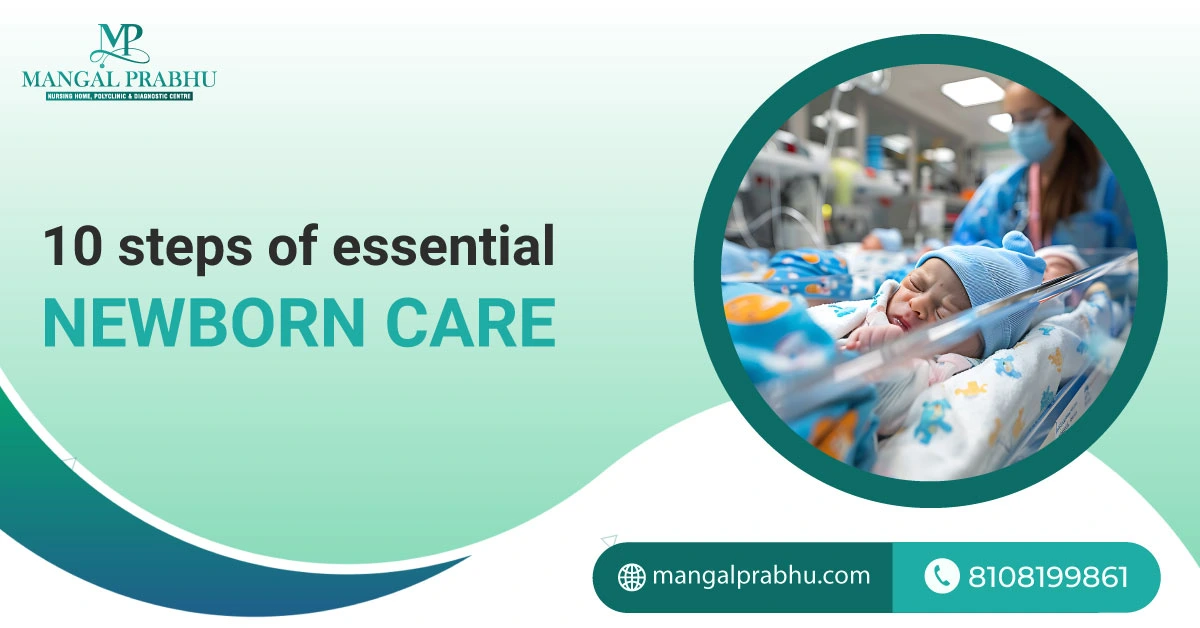
10 Steps of Essential Newborn Care
Newborn care is essential for healthy and proper development during those first precious moments and days. Your little one needs the best care and immense parental love and attention for steady growth.
To help you understand basic newborn care practices, we’ve researched 10 steps of essential newborn care that every parent needs to know. Here’s what to follow at the children’s hospital in Navi Mumbai and after discharge.
10 Steps of Essential Newborn Care:
Step 1: Immediate Skin-to-Skin Contact
Skin-to-skin contact, or the direct contact of the newborn with the mother, takes place naked on the mother’s chest, such that only her face is visible. Generally, most practitioners have been observed to conduct skin-to-skin contact within 10 minutes immediately after birth.
Soon after delivery, placing the baby on the mother’s chest tends to regulate the child’s temperature, breathing, and heart rate. It encourages bonding and provides emotional security right after delivery.
Step 2: Delayed Cord Clamping
Delaying the clamping of the umbilical cord to 1-3 minutes allows for more blood to continue flowing from the placenta to the baby. This generally helps boost the babies’ iron levels and reduces the chances of those babies developing anemia.
Step 3: Initial Breastfeeding
An early introduction to breastfeeding is essential. Breast milk provides the baby with all the nutrients and antibodies that protect them from infections.
Step 4: Proper Hygiene and Cord Care
Bathe the cord area and keep it dry to avoid infection. The cord will fall off automatically within a few days, so do not try to pull it off manually.
Step 5: Temperature Regulation
Newborns are sensitive to temperature, and warmth is essential for maintaining temperature levels. Cover them with blankets or warm clothes, especially in the first few days. However, void overclothing. The room temperature must be comfortable.
Step 6: Eyes Care and Administration of Vitamin K
Eye care involves newborn antibiotic eye ointment to prevent infection. A Vitamin K shot prevents newborns from getting bleeding disorders, which they are vulnerable to in the early days. Breast milk doesn’t have an adequate amount of Vitamin K, so it’s important to introduce them to vitamin K drops.
Step 7: Immunizations and Screening Tests
Newborns should receive their first vaccinations, including hepatitis B, to protect them from serious infection. Their screening tests, including hearing and metabolic, may identify problems early on.
Step 8: Monitoring for Jaundice
Jaundice is a common condition in newborns. Regular monitoring detects whether the skin or eyes start to yellow so treatment can begin before complications arise.
Step 9: Safe Sleep Practices
Newborns may be positioned on a firm mattress on their backs as a preventive measure against sudden infant death syndrome. Ensure that every loose bedding and pillow is removed from the baby’s sleeping environment.
Step 10: Regular Health Check-ups
Regular visits to the doctor in the first few weeks track development and check whether the baby is developing well and in tandem with set milestones. A pediatrician will walk parents through this crucial stage of assessment.
Conclusion
Following these 10 essential steps for newborn care ensures that your baby gets the attention and support needed for a healthy start, from skin-to-skin contact and regular check-ups to all the essentials covered here. Consult a pediatrician in Navi Mumbai for professional guidance and support during this vital stage.

Difference between Bronchitis and Pneumonia
You have a runny nose and a bad cough, and you seem to have chest congestion. How do you know if it’s a common cold or a respiratory illness? Bronchitis and Pneumonia are the two most common terms we encounter regarding respiratory diseases. Both are respiratory issues and have pretty similar symptoms.
So, how do you differentiate between them? A pulmonologist in Navi Mumbai can help you determine whether it’s pneumonia, bronchitis, or a common cold. In the meantime, here’s all you should know about these respiratory conditions.
Understanding Bronchitis
Bronchitis affects the bronchial tubes, which carry oxygen to the lungs. These tubes can become infected, inflamed, and swollen. It can be acute or caused by viruses or bacteria.
Causes of Bronchitis
Viruses mainly cause bronchitis, but in some cases, bacteria can be the culprit. In either case, the germs enter your bronchial tubes, and as your body tries to fight off the infection, the tubes get inflamed and swollen, making breathing difficult. Chronic bronchitis occurs in people who smoke cigarettes, inhale polluted air regularly, and live in a dusty environment.
Symptoms of Bronchitis
Acute bronchitis lasts a few weeks. Common symptoms include:
- A feeling of heaviness and fullness in the chest
- Yellow, green, or clear mucus
- Excessive coughing
- Runny nose
- Wheezing noise during breathing
- Shortness of breath
- Fever and chills
- Sore throat
Treatment of Bronchitis
Bronchitis can go away on its own within a few weeks. If it’s caused by bacteria, your doctor may recommend antibiotics. Inhalers are recommended for people with asthma, allergies, and chronic bronchitis. Your doctor may recommend lifestyle changes, such as quitting smoking or quitting work in a place that exposes you to irritants and harmful chemicals.
Understanding Pneumonia
Pneumonia affects the tiny air sacs called alveoli, which carry oxygen into the bloodstream. An infection can fill these air sacs with mucus, affecting their ability to contract and expand normally.
Causes of Pneumonia
Pneumonia can be bacterial, viral, or fungal. It happens when the germ enters the alveoli, which get swollen and filled with fluid as your immune system fights the infection. Pneumonia is more common in older people, babies, and people with weakened immunity.
Symptoms of Pneumonia
Pneumonia has similar symptoms to bronchitis. People with pneumonia experience:
- Cough that produces green or yellow mucus
- Chest tightness
- Chills and sweating
- Nausea
- Fever
- Shortness of breath
- Headache
- Blue lips
Treatment of Pneumonia
Treatment for pneumonia depends on the cause of the infection. If it’s bacterial, antibiotics are prescribed. If it’s viral, antiviral drugs can relieve your symptoms. Hospitalization might be needed in severe cases, although that’s not common.
Key Differences between Bronchitis and Pneumonia
Bronchitis occurs in the bronchial tubes, while pneumonia affects the air sacs. Bronchitis is mostly caused by viruses. Pneumonia, on the other hand, is bacterial but can be caused by viruses and fungi. Symptoms of pneumonia are more severe and can include confusion and blue lips, while bronchitis has flu-like symptoms, which aren’t that serious.
Conclusion
See your doctor immediately if you have a severe cough with mucus, shortness of breath, or chest pain. The sooner you get respiratory disorder treatment in Navi Mumbai, the faster you will recover.
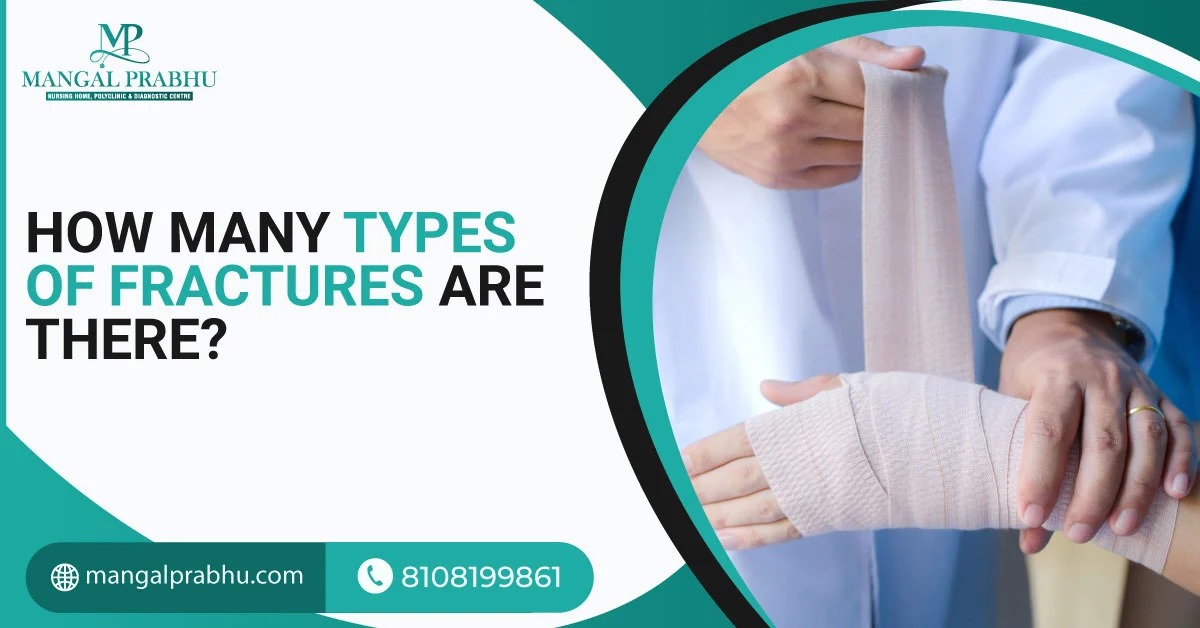
How Many Types of Fractures Are There?
Your bone density tends to decrease with age, increasing the risk of bone fracture. A bone fracture occurs when a heavy object hits your bones with a force greater than the bone can bear. The fracture can be minor; the bone may crack but doesn’t break completely. This can be fixed with casting and splinting. Or, it can be severe enough to break through the skin, increasing the risk of infection and other complications. In either case, it’s important to seek fracture treatment in Navi Mumbai to get your bones realigned. Read on to find out how many types of fractures are there.
Major Types of Fractures
a) Simple/Closed Fractures:
The bones break inside your skin but do not pierce through the skin. These are less complicated and often get better with immobilization and casting.
b) Compound/Open Fractures:
In a compound fracture, the bone fragments are visible on your skin. It creates a deep wound that requires immediate medical attention. You must see an orthopedic surgeon in Navi Mumbai to have it surgically repaired.
c) Greenstick Fractures:
Due to their increased bone flexibility, children are mainly affected by greenstick fractures. These occur when something hits their bones, breaking one side of the bone and bending the other.
d) Comminuted Fractures:
This is the worst type. The bones in comminuted fractures break into more than two pieces, often requiring a surgical repair. Because of their severity, comminuted fractures occur mostly during accidents and severe falls.
Specific Fracture Types
i) Transverse Fractures:
A transverse fracture results in the bone breaking horizontally into two pieces. It’s common in your leg or forearm bones. Treatment requires splints or surgery, depending on the severity of the damage.
ii) Oblique Fractures:
A sudden trauma to the bone can cause it to break diagonally. Oblique fractures are common in athletes, as they twist their arms and legs often during sports.
iii) Spiral Fractures:
Bones can also break spirally. Like oblique fractures, spiral fractures are common in people who forcefully twist their bones.
iv) Impacted Fractures:
Impacted fractures result in one end of the bone pushing into another due to serious trauma to the bones. These fractures can affect your ankles, hips, arms, and wrists. Since the bones do not break into pieces, you have a certain level of stability. That, however, doesn’t mean your bones are aligned. Treatment is required to restore your bones to their normal position.
Special Cases
A) Stress Fractures:
A fracture might occur from repetitive activities that put pressure on your bones. These are called stress fractures.
B) Pathologic Fractures:
These fractures occur because of a medical condition that can result in bone weakening to a degree that even a minor trauma can cause a severe fracture.
Prevention and Recovery
You can’t prevent situations, such as accidents or falls, that can lead to bone fractures. Here are a few tips that can help reduce your risk:
- Eat a diet rich in vitamin D and calcium
- Exercise regularly
- Resolve underlying medical conditions, such as osteoporosis.
Conclusion
Fractures are common during accidents and falls. Although anyone can get their bone fractured, people with low bone density are at an increased risk.

Effective Strategies in the Medical Management of Breast Cancer
Breast cancer diagnosis can be emotionally and physically challenging. However, advancements in technology and medical science have improved the survival rate and quality of life of many cancer patients. Depending on the stage of the cancer, breast cancer treatment in Navi Mumbai may involve surgery as a standalone procedure or combined with chemotherapy, radiation therapy, and hormone therapy.
In this post, we’ve explored some effective strategies in the medical management of breast cancer. Keep reading.
Early Detection and Diagnosis
The 5-year survival rate of women with breast cancer is 99% if it’s localized, i.e., if it hasn’t spread to the surrounding tissues and lymph nodes. The same is 86% for patients with regional breast cancer and 31% if it’s distant or has spread outside the breast tissue.
Screening Methods
Your health professional will conduct a thorough breast examination to detect any visible lumps that could be cancerous. They will also look at your breasts to check if your nipples and breasts look normal. Here’s what else can be used for detecting breast cancer.
1) Mammogram:
This is a type of breast X-ray that examines both breasts closely. If the mammogram shows anything unusual, another one will be ordered. This gives a detailed look at your breast tissues.
2) An Ultrasound:
Your healthcare provider may recommend a breast ultrasound, which can differentiate between a fluid-filled cyst and a cancerous mass. The doctors will decide whether further screening is needed depending on the test result.
3) MRI:
For an MRI, the patient is injected with the dye that gives a clear picture of both your breasts. This imaging test is used to detect how far the cancer has spread.
4) Biopsy:
A small sample of the breast tissues is used to detect cancerous growth.
Treatment Options
Your oncologist in Navi Mumbai might recommend the following treatment options:
a) Surgery
For most types of early-stage breast cancers, surgery is the most effective option. It’s possible to remove the tumor completely. This will prevent the likelihood of the cancer recurring. The surgery is called lumpectomy. If the tumor is large, a mastectomy (complete or partial removal of the breasts) might be needed.
b) Chemotherapy and Radiation Therapies
Chemotherapy can be given before surgery to shrink the tumor size, making it operable. It could be needed after surgery, as well. If cancer has spread beyond the breasts and has entered lymph nodes and nearby organs, chemotherapy, and radiation therapies followed by tumor removal are recommended.
c) Targeted Therapies
A targeted therapy attacks cancer cells by destroying the chemical mechanism in these cells. These are highly effective and have fewer side effects, as targeted therapies cause minimal damage to healthy cells. Most targeted therapies destroy the cancer cells that make extra HER2 (a protein responsible for the growth of cancer in your body).
d) Immunotherapy
Immunotherapy can be used for triple-negative breast cancer. The therapy signals your immune system to find and kill cancer cells. These treatment options are often used together to destroy cancer cells, slow their growth, and remove the mass from your breasts.
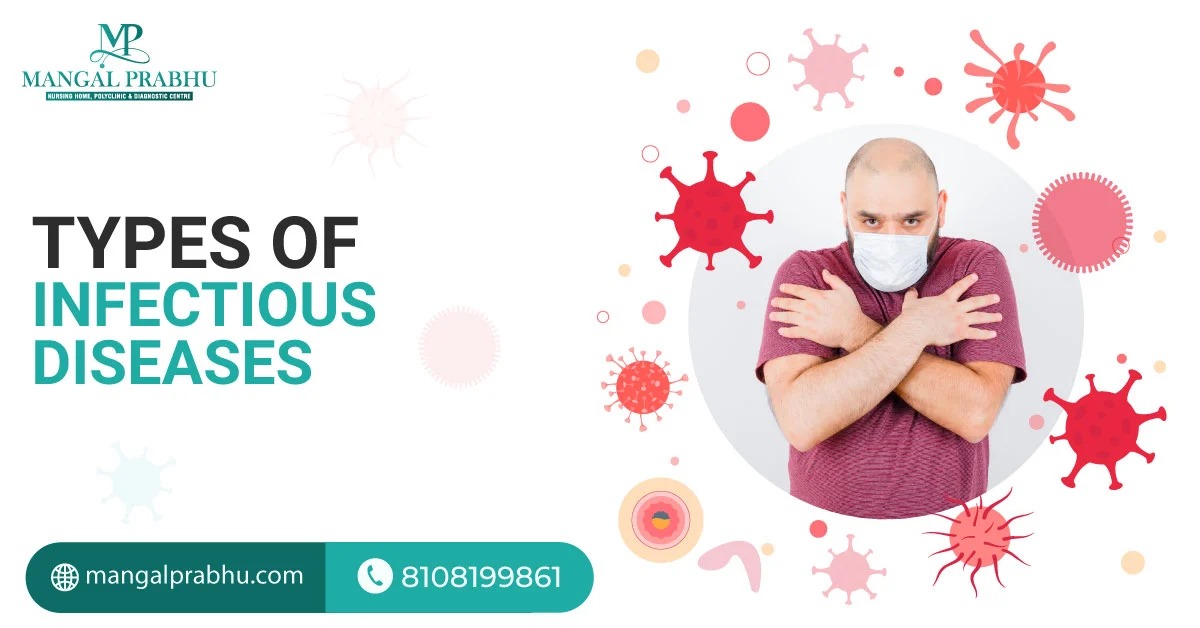
Types of Infectious Diseases
What is Infectious Disease?
Infectious diseases are caused by microorganisms, commonly called pathogens, that enter the human body and multiply. The symptoms, severity, prevention, and treatment of contagious illnesses vary depending on the type of pathogen that infects your body. It can be bacteria, fungal, viral, or parasitic.
The infection usually spreads through bodily fluid exchange, insect bites, skin-to-skin contact, ingesting contaminated liquids or food, and inhaling the contaminated droplets. Whether or not you need infectious disease treatment in Navi Mumbai depends on the type of infectious disease you’ve contracted. Let’s explore the most common ones.
1) Bacterial Infections
Bacteria are found in the human body and the environment. There are trillions of strains of bacteria, some of which are harmless and thrive in our body to fight bad bacteria. Others are, however, harmful enough to cause sickness from releasing toxins. Some severe bacteria-induced illnesses are:
- Strep throat
- Tuberculosis
- Cholera
- Typhoid
- Pneumonia
- Urinary Track Infections (UTIs)
Bacterial infections require antibiotics.
2) Viral Infections
Viruses are not capable of replicating themselves without support. They invade your cells to make multiple copies of themselves. Some viruses cause mild infections, like the common cold and flu. Others can lead to severe and life-threatening illnesses like HPV (that can turn into cancer). They spread from touching contaminated surfaces or if an infected person sneezes or coughs near you. Some common viral illnesses include:
- Common cold
- Coronavirus
- Hepatatits C
- Dengu
- Polio
- HIV
Viral infections do not respond to antibiotics. Fortunately, most mild viral illnesses will disappear with rest, over-the-counter medication, and increased fluid intake. Serious viral infections, like HIV and HPV, may require advanced antiviral treatment.
3) Fungal Infections
Fungal infections usually affect the upper layers of the skin but can go deeper in some cases. Ringworm, athlete’s foot, and candidiasis are the most common fungal infections. Although anyone can develop a fungal infection, people with a weakened immune system are at an increased risk.
If the condition affects your respiratory system, mouth, and other vital organs, you may need to see an infectious disease specialist in Navi Mumbai. Treatment usually involves topical and anti-fungal oral medication, although intravenous administration might sometimes be necessary.
4) Parasitic Infections
Parasites can invade your body and take nutrients from you to thrive. Parasitic infections cause abdominal discomfort, vomiting, diarrhea, and other intestinal symptoms, although they can affect the brain, lungs, and other organs too.
Tapeworm infection, for instance, are the common type of parasitic infection. They enter your body through undercooked meat. They don’t usually produce symptoms, but can cause severe neurological symptoms if they enter the brain. Other examples of parasite-based infections include:
- Malaria
- Toxoplasmosis
- Chagas
- Pinworms
- Cyclosporiasis
Antiparaistics are prescribed to treat parasitic infections. These can be used as standalone treatment or with antibiotics and antifungals.
Conclusion
Some infectious diseases are mild enough to resolve on their own within a few days, while others are severe and might even require hospitalization. To prevent infectious diseases, wash and sanitize your hands frequently, avoid contact with infected people, do not ear raw eggs or meat, and get vaccination.
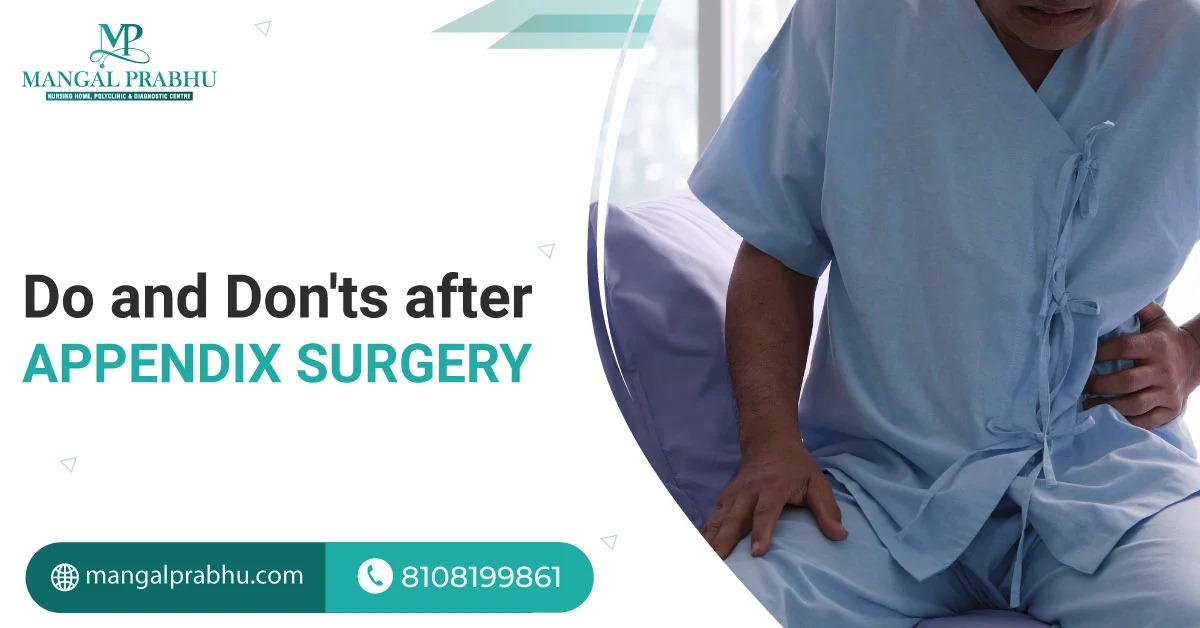
Do and Don’ts After Appendix Surgery
Located in the lower right side of the abdomen, the appendix is a small worm-like organ attached to your colon. An infection or an obstruction in the appendix can cause inflammation, requiring immediate surgical intervention. The surgery is called appendectomy and is carried out by a general surgeon in Navi Mumbai.
It’s considered an emergency in patients with a burst appendix, as the infection can spread to other parts of the body and become life-threatening. After surgery, you will stay in the hospital for a few days, especially if you had surgery for a ruptured appendix. Here are some dos and don’ts after appendix surgery for faster recovery.
Do’s after Appendix Surgery
a) Follow Your Doctor’s Instructions:
Your doctor will guide you during recovery. You may also need to schedule follow-up visits to ensure you are healing well.
b) Take Prescribed Medications:
Your surgeon will prescribe painkillers and antibiotics for the first few days. Take medication as prescribed by your doctor.
c) Maintain a Healthy Diet:
Start small with light foods, preferably liquid. Move to the soft solids, like mashed potatoes, mashed fruits, oatmeal, rice, yogurt, and scrambled eggs. Ask your doctor when it’s safe to eat normal food. Once you get the doctor’s approval, add more veggies and fruits, with proteins and omega-3 fatty acids, to your diet.
d) Get Plenty of Rest:
Like any surgery, recovery from appendectomy requires adequate rest. You should limit your physical activity and take 2-3 weeks off from work.Practice Light Physical Activity: Rest doesn’t mean you should go on bed rest and not move. Light physical activity, like walking, is an important part of your recovery after surgery. It helps prevent blood clots and other post-surgical complications.
Don’ts after Appendix Surgery
i) Avoid Strenuous Activities:
Do not put pressure on the surgical site, and avoid exercising or any strenuous physical activity for the first four weeks following appendectomy. Cycling, swimming, running, and all kinds of heavy exercises should be avoided during this period.
ii) Don’t Lift Heavy Objects:
Weight lifting should be avoided. Don’t lift anything heavier than 7-8 pounds until your doctor says it’s okay.
iii) Refrain from Consuming Alcohol:
Alcohol can delay your recovery, as it affects your immune function, increasing the risk of complications after surgery. Besides, alcohol can interfere with your pain relief and antibiotic medication.
iv) Avoid Smoking:
Likewise, smoking increases your risk of infection. It can constrict blood vessels, interfering with the oxygen supply to the tissues. This can affect post-surgical recovery.
v) Don’t Strain During Bowel Movement:
Eat a fiber-rich diet to prevent constipation. If necessary, you can ask your doctor to recommend a stool softener.
vi) Don’t Ignore Warning Signs of Complications:
If you notice pus or bleeding from the incision site accompanied by fever and vomiting, call your doctor immediately, as these might be signs of infection.
Conclusion
Recovery from appendix surgery in Navi Mumbai should take no longer than six weeks. Stay in touch with your doctor and update them about your healing. Eat small, frequent meals, stay hydrated, and sleep well.
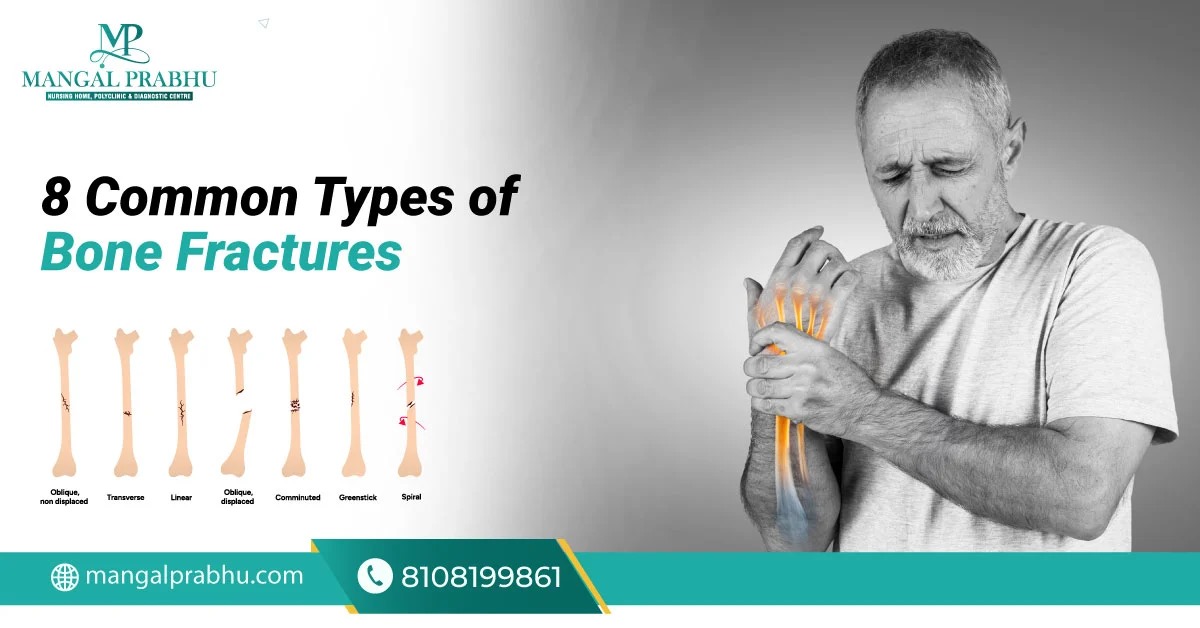
8 Types of Bone Fractures
Bone fracture refers to the broken or cracked bones. Although anyone at any age can experience a bone fracture, they are more common in older people (above 50 years). The risk is higher in people diagnosed with osteoporosis. Visit an orthopedic hospital in Navi Mumbai for bone density screening. The test detects weak and brittle bones and also suggests your likelihood of getting bone fractures. In the meantime, let’s explore the eight most common types of bone fractures.
8 Types of Bone Fractures
1) Simple Fracture
A simple fracture occurs when the bone breaks but does not cause any visible injury on the skin or break through your skin. There’s no severe tissue damage, as the bone is contained within your body. The bone might slightly displace or remain completely aligned with little damage to the soft tissue. Rest and immobilization are the most effective treatment options for simple fractures.
2) Compound Fractures
A compound fracture is more severe than a simple fracture. It occurs when the bone breaks and pierces your skin, leading to a severe wound. It’s caused by a fall from a great height or a car accident that puts excessive force on your bones, causing them to break and injure your skin. You will notice the bone sticking out of your skin and severe bleeding. See an orthopedic doctor in Navi Mumbai immediately if you notice these signs.
3) Comminuted Fractures
A car crash or other severe accident can result in your bone getting broken into many pieces. It’s another serious type of bone crack that requires hospitalization. The treatment for comminuted bone fractures is a surgical repair. The broken bones can take a year or longer to heal completely.
4) Greenstick Fractures
In greenstick fractures, your bone bends so much that it cracks slightly but does not break into multiple pieces. They result from sports injuries, falls, and other kinds of trauma. They are common in children, as children’s bones are weaker compared to adults.
5) Transverse Fractures
A transverse fracture is a bone crack that goes straight across the bone. It looks like a horizontal cut. The crack occurs from a fall or a heavy object hitting your bone. Immobilization is usually recommended for transverse fracture, but surgery might be needed if the bones’ alignment is affected.
6) Oblique Fractures
An oblique fracture is a diagonal crack, usually found in the long bones. These also occur from trauma to your bone due to a fall or an accident.
7) Spiral Fractures
Spiral fractures occur due to a sudden twisting motion, especially during strenuous physical activities or sports. These look like a corkscrew, a spiral line that goes all the way around the bone.
8) Compression Fractures
Compression fractures occur in the vertebra in your spine. They are most common in people with osteoporosis or a weakened spine, which is likely to collapse if you experience a fall, injury, or any accident that hits your spinal area.
Conclusion
Bone fractures are common and mostly occur because of trauma to your bones. These are more common in people with weaker bones (especially elders) than healthy ones. Treatment includes immobilization and surgery in severe cases.
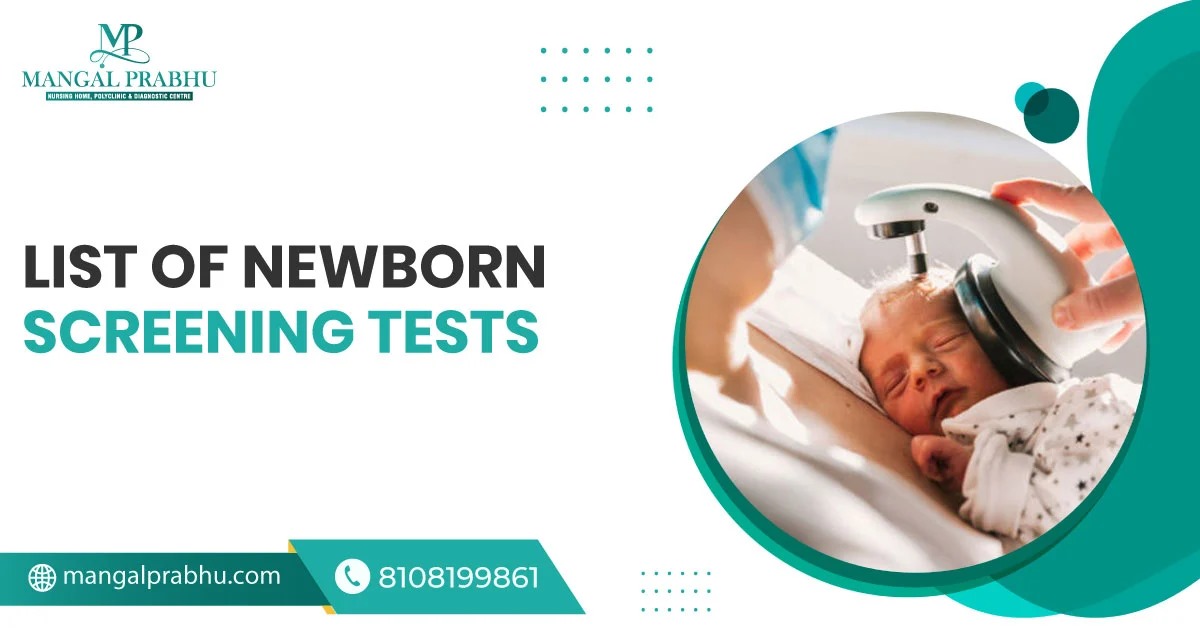
List of Newborn Screening Tests
When a baby is born, they are tested for severe yet rare medical conditions that can be fatal to the baby’s health if left undiagnosed and untreated. Your baby might not show signs of illness, so newborn screening tests are mandatory for all babies. Early detection is crucial, as it helps the pediatrician in Navi Mumbai identify problems that require medical attention.
If you are also close to your delivery date, knowing about different newborn screening tests is essential to childbirth preparation. Below, we’ve compiled a list of the common screening tests conducted at most children’s hospitals in Navi Mumbai.
Common Newborn Screening Tests
1) Hearing Screening:
The healthcare provider will use tiny microphones to detect how your baby responds to sound. The doctor connects the microphone to a monitor, which records the echo produced by your baby’s ears. The hearing test shows whether your baby has a normal hearing capacity.
2) Metabolic Disorder Screening:
Your baby will be tested for metabolic disorders before they leave the hospital. Metabolism refers to your body’s ability to convert food into energy. Problems with a newborn’s metabolism can lead to life-threatening consequences when left untreated. The healthcare provider will take a blood sample from your baby’s heel and send it to the lab for testing.
3) Critical Congenital Heart Disease (CCHD) Screening:
The pulse oximetry test is a simple test that detects heart disease in newborns. It takes barely five minutes and is performed using a sensor that detects the oxygen in your baby’s blood and pulse rate.
Conditions Detected by Newborn Screening
Newborns with metabolic disorders are unable to process foods properly. This can lead to a wide range of disorders, some of which can affect brain function and cause liver damage. Metabolism test detects problems like hypothyroidism, cystic fibrosis, sickle cell disease, Phenylketonuria, and galactosemia.
Most genetic disorders in newborns are related to their metabolism, blood function, and hormones. In addition to the above-listed issues, the test can detect Maple Syrup Urine Disease. This condition suggests your body’s inability to process certain amino acids, leading to their accumulation in the body. This may eventually result in brain damage. Spinal Muscular Atrophy is another genetic disorder that causes muscle weakness and respiratory issues.
What to Expect After Screening
If the test results are normal, you can go home. If one of the tests shows a positive, that doesn’t mean the baby has a disorder. The doctor will schedule further testing, often called confirmatory tests, to confirm the diagnosis.
If the confirmatory tests confirm the disorder, your healthcare provider will work with an endocrinologist, dietician, cardiologist, and other qualified pediatricians to plan the treatment.
Certain conditions detected in newborn screening require regular monitoring. You will be asked to monitor their developmental milestones and whether they are growing like normal babies.
Conclusion
Newborn screening tests are essential for every baby. The hospital will conduct these tests on the first or the second day of childbirth. Some hospitals send you a copy of the reports. You can have them cross-checked by your pediatrician.
